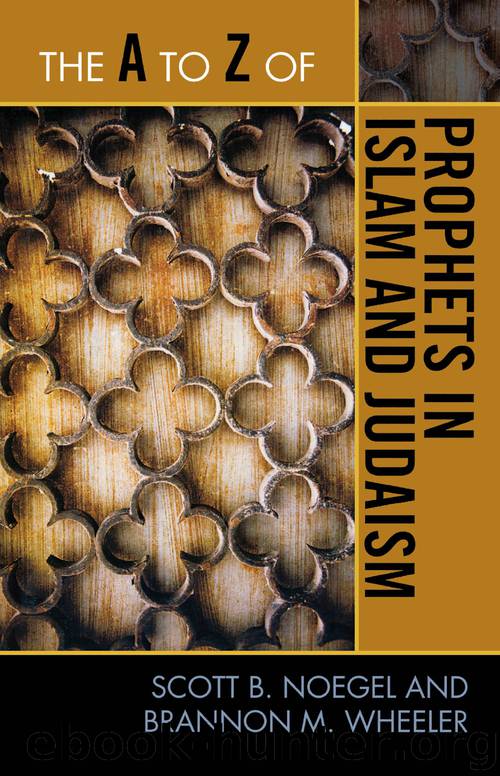The A to Z of Prophets in Islam and Judaism by Scott B. Noegel & Brannon M. Wheeler

Author:Scott B. Noegel & Brannon M. Wheeler
Language: eng
Format: epub
Publisher: Scarecrow Press
Published: 2002-03-14T16:00:00+00:00
– N –
NABI. Standard biblical Hebrew term for prophet with a long history in the ancient Near East (see also PROPHET). The term also appears in Arabic as the standard word for a prophet, and is used in the Quran roughly 50 times, though less frequently than the term often translated as “apostle” [Ar. rasul] (see also APOSTLE).
NABONIDUS. Last of the Babylonian kings (555–539 BCE) and a usurper who is referred to in Babylonian sources as having deserted Babylon and its god Marduk in favor of his hometown Haran and the worship of the moon god Sin. Afterward he fled to Tema in northern Arabia. For this act of hubris, the gods struck Nabonidus with lycanthropy; the text describes him as behaving like an animal. For this behavior he was remembered even beyond Babylon as an “insane” king. The descriptions of his act of hubris share much in common with the Prayer of Nabonidus (4QPrNab) found among the Dead Sea Scrolls (75–50 BCE), and his resulting divine lycanthropy closely resembles the description of the Babylonian king Nebuchadnezzar in the book of Daniel (Dan 4:15–32).
NAG HAMMADI. Site located near al-Qasr (ancient Chenoboskion), nine kilometers from the ruins of the Basilica of St. Pachomius, where 13 codices were discovered in 1945 dating back to the fourth century CE. Preserved in the codices are Coptic texts reflecting early Christian and other late antique religious ideas, including part of Plato’s Republic and Asclepius. The texts appear to have been translated into Coptic from Greek by a number of different scribes thought by some scholars to be Pachomian Christian monks. The standard edition of the codices lists them according to the number of the codex and the number of the tractate in each codex (I,1-XIII,2). Some are extremely fragmentary, and others are attested by more than one copy. The types of texts found include apocalypses, commentaries on the Bible, gospels, letters, acts, doctrinal treatises, homilies, and prayers. Some are known from references in other sources, and most of them are clearly gnostic in character (see also GNOSIS AND GNOSTICISM). The discovery of these codices is comparable to the discovery of the Dead Sea Scrolls, having brought to light many otherwise unknown texts that help to fill out the rich spectrum of ideas found in late antiquity.
NAHUM. Book of prophecies of Nahum, a prophet whose hometown of Elkosh is unknown, and who apparently lived through the destruction of Nineveh in 612 BCE. Since the prophecy mentions the Assyrian sack of Thebes it cannot predate 663 BCE. The book is unique in that it contains no negative pronouncements of doom, but offers only a cry for joy over the fall of Nineveh.
NARSAI (c. 399–503 CE). East Syrian or Nestorian scholar, also known by “Narses,” the Latinized form of his Persian name. Narsai was raised in a monastery and studied at the School of Edessa, over which he became director in 451 CE. He was a close follower of the theology of Theodore of Mopsuestia (c. 350–428 CE), who believed in the separate divine and human natures of Christ.
Download
This site does not store any files on its server. We only index and link to content provided by other sites. Please contact the content providers to delete copyright contents if any and email us, we'll remove relevant links or contents immediately.
| Africa | Americas |
| Arctic & Antarctica | Asia |
| Australia & Oceania | Europe |
| Middle East | Russia |
| United States | World |
| Ancient Civilizations | Military |
| Historical Study & Educational Resources |
Cecilia; Or, Memoirs of an Heiress — Volume 1 by Fanny Burney(32433)
Cecilia; Or, Memoirs of an Heiress — Volume 2 by Fanny Burney(31866)
Cecilia; Or, Memoirs of an Heiress — Volume 3 by Fanny Burney(31850)
The Secret History by Donna Tartt(18839)
Sapiens: A Brief History of Humankind by Yuval Noah Harari(14244)
Leonardo da Vinci by Walter Isaacson(13179)
The Radium Girls by Kate Moore(11921)
Sapiens by Yuval Noah Harari(5293)
How Democracies Die by Steven Levitsky & Daniel Ziblatt(5127)
The Wind in My Hair by Masih Alinejad(5033)
Homo Deus: A Brief History of Tomorrow by Yuval Noah Harari(4818)
Endurance: Shackleton's Incredible Voyage by Alfred Lansing(4676)
The Silk Roads by Peter Frankopan(4456)
Man's Search for Meaning by Viktor Frankl(4418)
Millionaire: The Philanderer, Gambler, and Duelist Who Invented Modern Finance by Janet Gleeson(4373)
The Rape of Nanking by Iris Chang(4136)
Joan of Arc by Mary Gordon(4012)
The Motorcycle Diaries by Ernesto Che Guevara(4009)
Hitler in Los Angeles by Steven J. Ross(3900)
